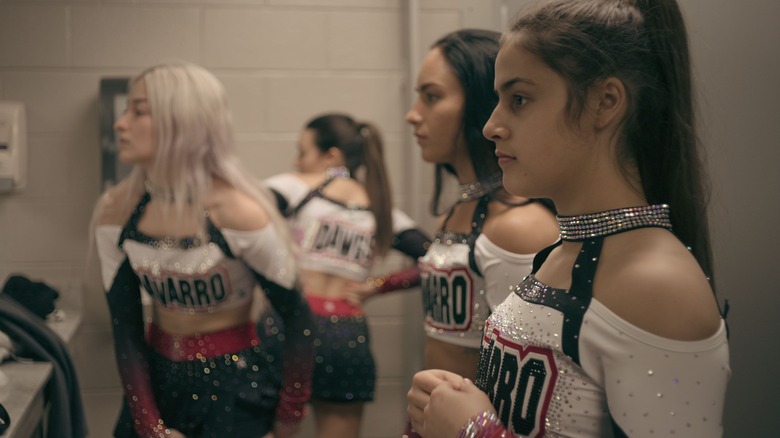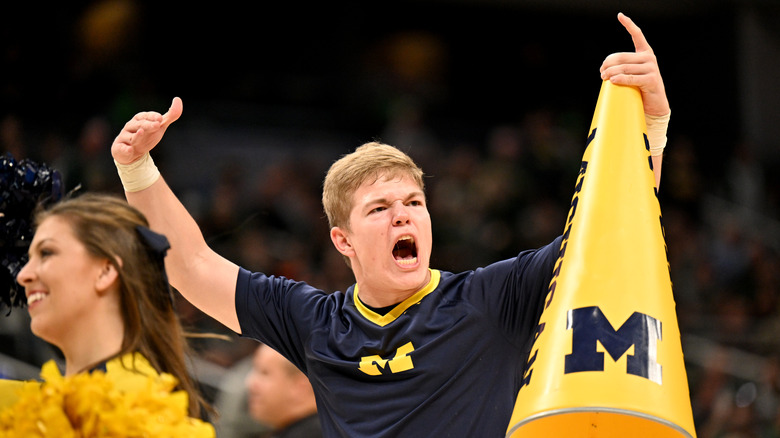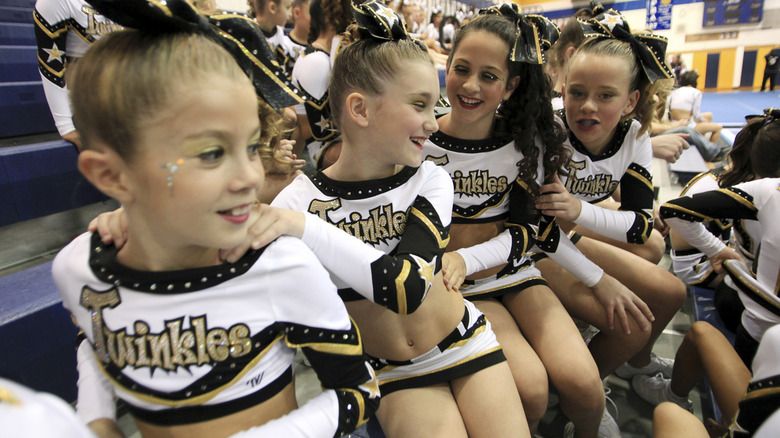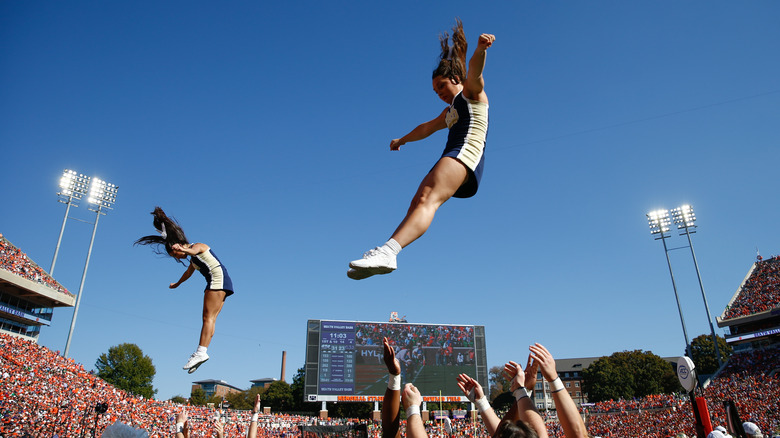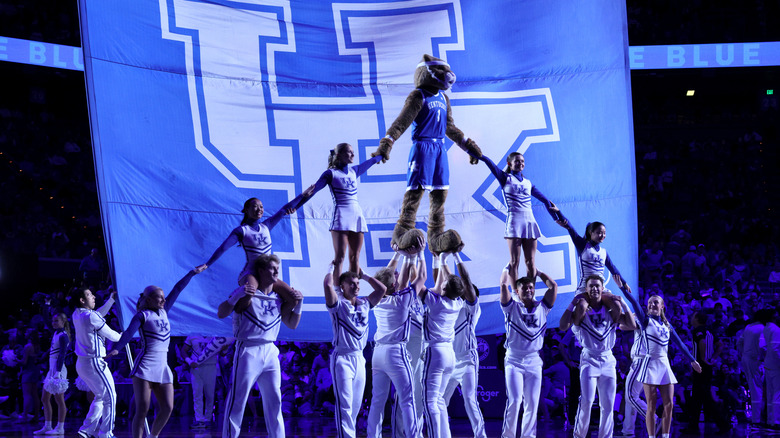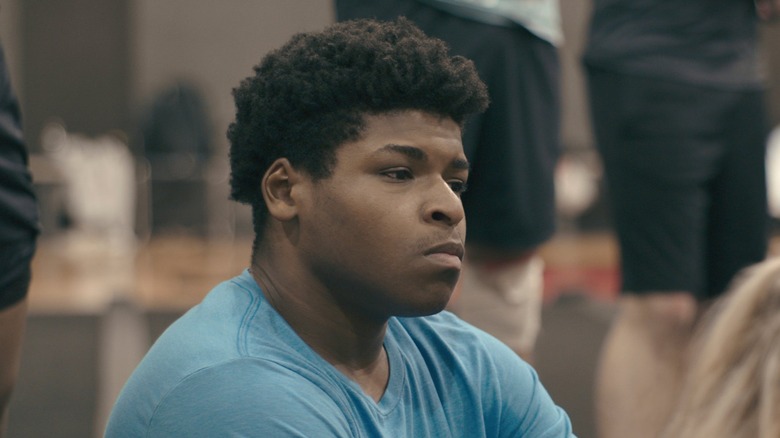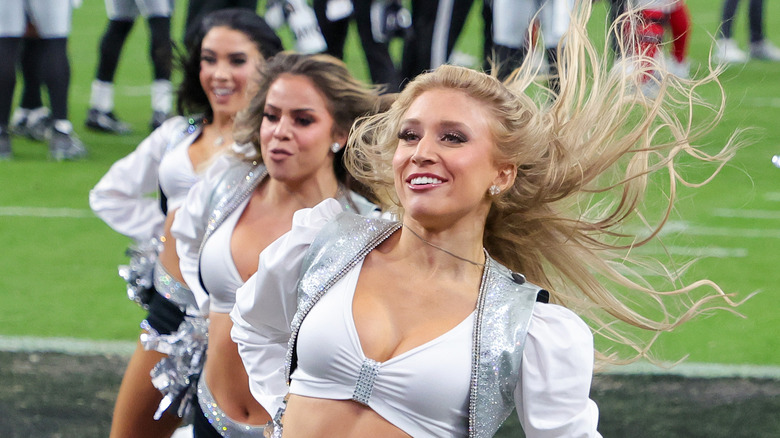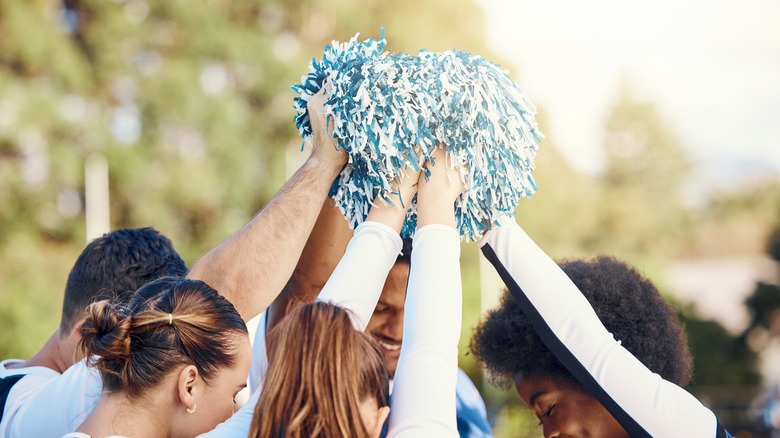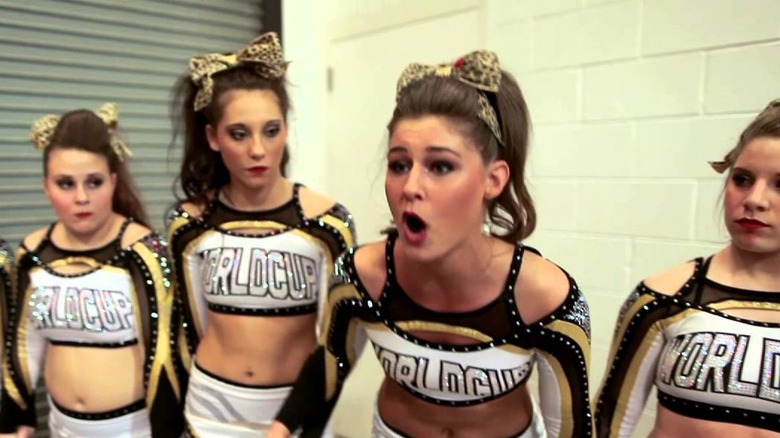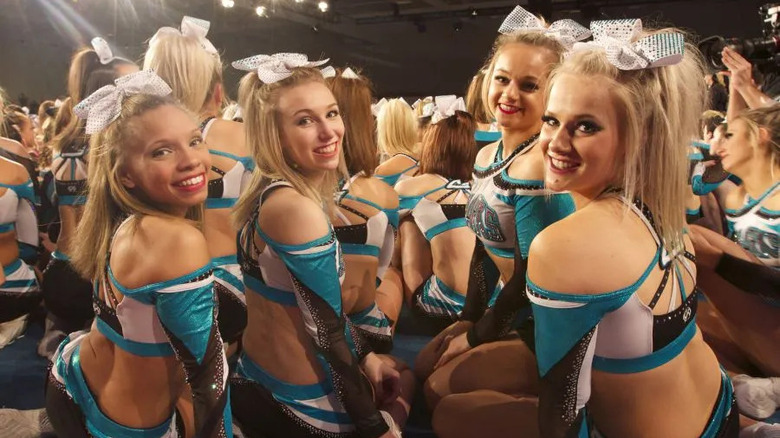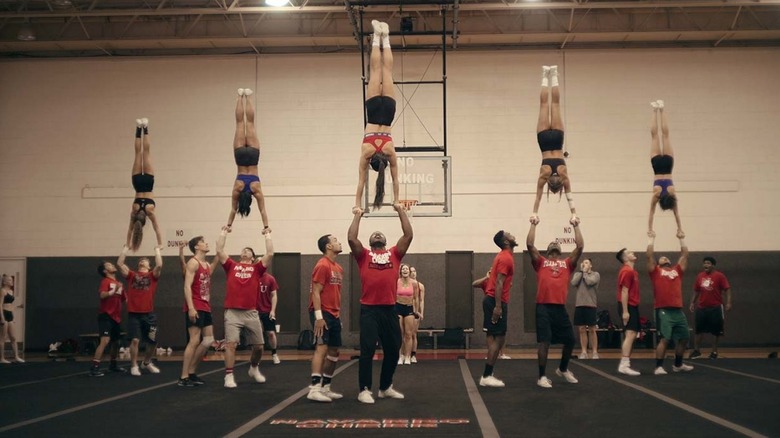Dark Secrets Of Cheerleading Revealed
Cheerleading is as much a part of the American identity as hot dogs, apple pie, and of course, the sports that cheerleaders cheer for. At high schools and colleges across the country, communities organize around game days, and cheerleaders are as integral to the experience as are the marching bands and the athletes themselves. There exists an iconic image in the public imagination of the cheerleader in a pleated skirt and varsity sweater, with her hair done up in a ponytail, waving pom poms or shouting rhymes into a megaphone. That image projects wholesome, clean-cut, small-town femininity. But the stereotypical ideal is just that ... a facade that hides the darker reality of this unique cultural phenomenon.
A deeper look into the world of cheerleading reveals a subculture rife with exploitation, abuse, under-regulation, and crony capitalism. Cheerleading is a lifestyle that can lead to financial stress, poor body image, and grotesque injury. And as the sport (and even the use of the word "sport" is controversial when it comes to cheer) has evolved, the problems that plague it have only gotten worse.
It's rooted in sexism
Today, cheerleading is thought of as an activity that's predominantly for girls. It is. According to a UCLA study, participation in cheerleading is approximately 97% female (though more male cheerleaders can be found on squads at the college level). But it wasn't always that way. The activity that would come to be known as cheerleading began to form in the mid-to-late 1800s, first at Ivy League schools, as male students in the stands organized the chants they used to support their teams. It took off as a more widespread trend when Princeton alum Thomas Peebles relocated to the University of Minnesota and introduced the concept to the student body there. As colleges and universities were only starting to admit women in the 19th century, few if any female students would've been involved.
Cheerleading became a spectator sport in its own right as well as entertainment for the crowds as props like flags and megaphones and acrobatic stunts were incorporated into the routines. Squads were still largely male, although female students were sometimes permitted to audition, but female cheerleaders were a rarity ... until World War II. With many young men serving overseas, women — as they did in other walks of life — stepped in to fill the void. However, their inclusion forever changed cheerleading. The president of Kilgore College is often credited with creating the archetype of the modern cheerleader. He re-envisioned cheerleading as entertainment for male fans, with more seductive choreography performed by attractive women in showy costumes. As a result, men all but fled the sport.
It fetishizes young girls
Seventy years on, cheerleaders still use pom poms and megaphones, and at the high school and college levels, the uniforms at least still reference academic institutions. But the stereotype that was born at Kilgore College in 1939 stuck, and it quickly trickled down from co-eds to younger and younger girls. In addition to the iconography that comes from the early 20th century, today's cheerleaders often wear heavy makeup, large bows and hairpieces, and extremely tight, short, and revealing ensembles. One could argue that's not entirely dissimilar from gymnastics or figure skating, in which athletes wear costumes and makeup. But the cheerleading aesthetic tends to combine youthful innocence with fetishistic sexuality. That might be acceptable for older teens and adults who choose to participate in the activity on those terms, but for grade school-aged girls, early sexualization is forced upon them when they're styled in the expected fashion.
And it's not just the clothes and lipstick. A Ms. Magazine essay by Carmen Siering details how a parent was troubled when her 6-year-old daughter came home from a cheer practice reciting a sexually suggestive verse. "Our backs ache, our skirts are too tight, we shake our booties from left to right!" the cheer went. When that parent complained, a media firestorm was ignited, and the girl was eventually cut from the team. At least in that municipality, the idea of first graders shaking their booties in tight skirts was seen by the majority as unproblematic.
Cheerleaders are at risk for eating disorders and body dysmorphia
Another component of the cheerleader mystique is the cache that comes with making the squad. In American high schools, cheerleaders are perceived as having social advantages like higher status and a built-in network of friends. But the privilege of being a cheerleader isn't all it's cracked up to be. Pre-teen and teen girls are already under an immense amount of pressure, especially as it pertains to their looks. A 2004 study in the Journal of School Health reported that 50% of Black cheerleaders and almost 75% of white cheerleaders were unhappy with their bodies. Almost half of the cheerleaders indicated that they were actively trying to lose weight.
A 2012 study published in the Journal of Athletic Training found that more than 33% of cheerleaders were at risk of having an eating disorder. That number rose when flyers — the person who performs aerial stunts — were singled out. Flyers are expected to maintain their small frames and low body mass indexes. It's a competitive position, and to keep their spot on the team, it's been hypothesized that they might be more vulnerable to anorexia nervosa or bulimia, though further study with larger sample sizes is needed. That study also concluded that skimpy uniforms, particularly midriff-baring tops, could also account for cheerleaders' anxiety about body image.
Hazing is rampant
Participation in sports and extracurricular activities, including cheerleading, can have dramatically positive effects on a child's physical and mental well-being and can even keep them out of trouble. At its best, cheerleading offers a high school or college student opportunities to socialize, exercise, and work toward goals. But affiliation with longstanding, organized groups can have downsides, too. A National Study of Student Hazing discovered that 55% of those involved with school activities experienced some kind of ritual abuse including but not limited to forced alcohol consumption, sleep deprivation, public humiliation, or coerced sex acts. Though hazing is not unique to cheerleading, it's still a problem.
In recent years, cheerleading hazing scandals have come to light at the University of Kentucky, Northwestern University, the University of Kansas, and the University of Central Oklahoma. All of these incidents involved public nudity and sexual harassment. In some cases, coaches were fired, but on the whole, affected cheerleaders feel that more needs to be done to improve the type of campus culture that can lead to such harmful practices.
Hazing doesn't just happen at the university level. In September 2023, a New Hampshire high school put a pause on its entire cheer program after allegations of hazing. While an investigation did find isolated incidents of bullying and discrimination, the investigation cleared most of the participants. Unfortunately, these types of allegations aren't uncommon, and even high school cheer hazing can take the form of sexual violence.
Abuse has occurred at all levels
Ritual hazing isn't the only threat cheerleaders face. Here again, comparisons to the world of gymnastics are inevitable. While that sport was rocked by the Larry Nassar scandal in 2016, the world of competitive cheerleading was shaken by a similarly headline-worthy debacle in 2020 when one of the breakout stars of Netflix's "Cheer," Jerry Harris, was accused of sexual assault of several teenage boys. In 2022, Harris was sentenced to 12 years in prison, after being found guilty of solicitation of minors and child pornography. Netflix's PR nightmare might be the most infamous case of abuse within the cheerleading community, but it's not even the tip of the iceberg.
There were at least 12 active federal investigations into the alleged sexual abuse of cheerleaders as of January 2023. Often, the perpetrator is the adult who leads the program. In New Jersey, a coach named Jonathan Ryker targeted girls between the ages of 15 and 17. In South Carolina, the owner of a gym was accused of having provided nine underage girls with drugs and alcohol in his efforts to sexually harass and abuse them. He was found dead of a self-inflicted gunshot wound shortly thereafter.
The problem extends all the way to the NFL. The Dallas Cowboys had to pay a $2.4 million settlement after four former cheerleaders claimed that an executive had engaged in voyeurism in the locker room without their knowledge or consent, and elsewhere in the league, cheerleaders have been pressured to pose semi-nude for calendars and to escort powerful men to dinner.
If you or anyone you know has been a victim of sexual assault, help is available. Visit the Rape, Abuse & Incest National Network website or contact RAINN's National Helpline at 1-800-656-HOPE (4673).
Professional cheerleaders aren't paid or treated well
Young cheerleaders may watch professional sports on TV and dream of becoming a professional cheerleader themselves. After all, from those bright white smiles to those sparkly outfits, the job looks fun and glamorous. But that couldn't be further from the truth. NFL cheerleaders aren't just subject to those documented cases of sexual harassment, they're mistreated when it comes to the hours they work and the wages they're paid. Any little girl aspiring to be a Dallas Cowboy would be shocked to learn that, from the 1970s to the 1990s, they were compensated just $15 per game. In 2014, former Oakland Raiderette Lacy Thibodeaux-Fields filed a class action lawsuit against the NFL regarding compensation. At the end of the 2013-2014 season, she was only paid $1,250. A similar lawsuit followed from a group of Buffalo Bills cheerleaders.
Women were expected to purchase their own equipment and uniforms, and their wages only covered performances, not practices, and not always mandatory community appearances. Some contracts also stipulated that they maintain a certain weight, and one even forbade them from wearing sweatpants in public. All said and done, an NFL cheerleader's salary came out to well below minimum wage, with no job protection to speak of and borderline illegal working conditions. While both Thibodeaux-Fields and the Buffalo Jills won a settlement (although the Jills disbanded in 2014), the scandals hardly made waves. Because pro teams try to categorize cheerleaders as independent contractors and not employees, they can get away with practically making women work for free in these highly competitive positions.
Cheerleading isn't a sanctioned sport
There's a reason professional athletes make six- if not seven- or eight-figure salaries while professional cheerleaders barely break even on their expenses. Elite high school athletes can receive funds to continue their educations in college because their sports are officially sanctioned as such under Title IX or by the NCAA. Some of those sports can be played professionally. Though only the tiniest fraction of equally talented and lucky wannabe athletes will make it to the pros, there's a set path for them to follow, and in addition to helping student athletes achieve their goals, that path comes with valuable protections, too.
Cheerleading has never been recognized as a sport by either the NCAA or Title IX. When Quinnipiac University tried to replace volleyball with cheerleading, a lawsuit went all the way to the United States District Court. Judge Stefan R. Underhill stated in his 2010 ruling, "Competitive cheer may, some time in the future, qualify as a sport under Title IX; today, however, the activity is still too underdeveloped and disorganized to be treated as offering genuine varsity athletic participation opportunities for students." That decision was upheld in federal appeals court two years later, in 2012. Because cheerleading lacks official recognition, it also lacks state or national guidelines that help keep sports safe and fair for children. Those protocols instead fall under the jurisdiction of the private industries that currently regulate this hobby that requires just as much athleticism and commitment as a sport.
Competitive cheer can feel like a scam
Speaking of private industry, cheerleading may have originated as a school-affiliated pastime, but competitive cheer gyms that have no ties to high schools or colleges have become more and more ubiquitous in towns and cities across America. Could the families that patronize them be falling for a scam? Potentially.
It works like this: Parents sign their kids up for memberships at gyms and clubs that can cost hundreds of dollars a month, and those costs rise as athletes progress into higher-level groups. But that's not all. They're on the hook for uniforms and other supplemental clothing, shoes, and accessories, which can add hundreds more to the bottom line. Athletes are encouraged to attend costly overnight camps, and then there are the competition fees and travel expenses. The yearly commitment can easily total several thousand dollars.
Club sports are prohibitively expensive, and it's a problem that poor kids are priced out of participation. But remember, cheerleading isn't technically a sport. If you've ever wondered why so many teams make it to "nationals," it's because there isn't just one national cheerleading championship. On their own website, influential industry leader Varsity Brands brags that there are more than 40 "brands" under which clubs can compete. Season 8, Episode 1 of "Penn & Teller: Bulls***!" exposed how Varsity alone hosts 66 different national championships. Most take place in Florida and are packaged with trips to Walt Disney World. This not only calls into question the merits of awards but suggests cheerleading has become, first and foremost, a for-profit enterprise.
One company has a monopoly on the industry
All the fees associated with club cheerleading are marked up, meaning every vendor along the way — from uniform manufacturers to Orlando-based hotels — is charging more than the product or service they offer actually costs. But that's capitalism, right? Not so in the world of competitive cheer. Varsity Brands was recently the subject of three federal antitrust lawsuits. Plaintiffs alleged that Varsity was a monopoly that crippled competition either by acquiring smaller rivals or by coercing them into signing exclusive contracts. As a result, Varsity (a subsidiary of Bain Capital) had seized control of almost every aspect of the cheerleading market, from the manufacture and sale of all that rhinestone-studded apparel to the hosting of all those national championships.
Private gyms effectively had to purchase Varsity Brand costumes or sign up for Varsity Brand competitions; any team that didn't play by Varsity's rules risked being pushed out of the cheer ecosystem. And, because Varsity created both organizations that govern cheerleading (USA Cheer and U.S. All-Star Federation) there was nobody impartial to complain to about any corruption. Varsity's grip on the industry gave the company the power to price-fix and the power to sweep problems under the rug. The for-profit entity has a vested interest in keeping cheerleading from becoming a Title IX or NCAA sport because it would lose its near-total influence and oversight (not to mention tons of money). Varsity has also been accused of turning a blind eye to sexual abuse, too. In March of 2023, the company agreed to pay $43 million in damages and change some of its practices as part of a settlement.
It's incredibly dangerous
Cheerleading has evolved from spontaneous chanting at 19th-century college games into a 21st-century activity that requires just as much (if not more) strength and skill than any other sport. While it would vindicate cheerleaders' efforts to recognize it as such, the most pressing reason to do so would be to create and enforce universal safety standards for the millions of kids and young adults who put themselves in harm's way doing pyramids and basket tosses.
Multiple studies have shown that cheerleading is responsible for about 65% of all catastrophic injuries suffered by female athletes. Concussions are common, as are broken bones and damage to tissue and ligaments. A bad fall can lead to a lengthy recovery process, and compounding concussions can and have affected students' performance at school.
Because cheerleading isn't taken as seriously as, say, football, athletes' health concerns aren't always taken as seriously, either. National standards regulating issues such as the mats and surfaces upon which cheerleaders perform or the training of coaches and officials could help mitigate the problem. But, as the sport-that-isn't-a-sport becomes more popular and more extreme stunt-based, the risk of catastrophic injury appears to be one the majority of competitive cheerleaders are willing to take.
